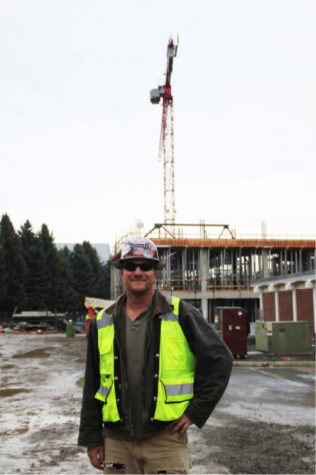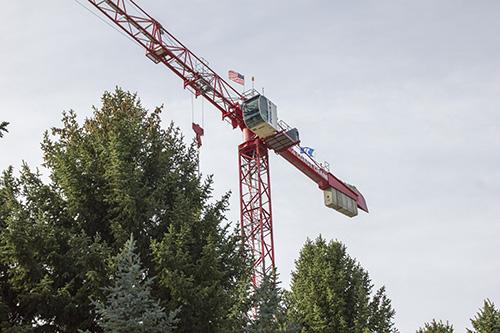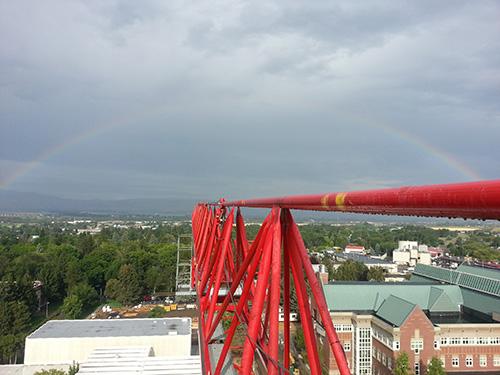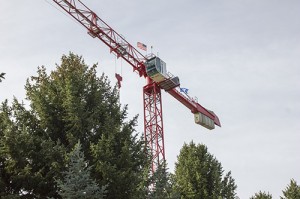Central’s crane operator works with a view on Science Phase II
November 7, 2014
Being a tower crane operator might seem like a lonely profession to some people, but not to Lyle Mattheson, the tower crane operator who has been running the red crane at the Science Phase II construction site.
“Being up there all day, I like it,” Mattheson said. “I love being a tower crane operator. I wish I would’ve done it earlier in my life.”
At the beginning of his career, Mattheson did not have a specific path planned out. He grew up around the body shop his dad owned, and gained experience in the construction field doing dirty work.
He worked for Boeing, owned his own fiberglass workshop and dabbled in road construction. He eventually closed his shop and pursued his crane operation certification at the Operating Engineers Regional Training Program in Kittitas County.
“The schooling was fun,” Mattheson said. “It was way different than anything I’ve ever experienced.”
Though he came into the program with experience as a dirt equipment operator, Mattheson was determined to become a crane operator.
“I knew that’s what I wanted to do, because I love heights,” Mattheson said.
Mattheson is able to do his job effectively because he has no fear. Being up in the crane is exhilarating to him, and he wouldn’t have it any other way.
“I like all of it, I like the fast pace of everything,” Mattheson said. “It’s what keeps me going back to it.”
Mattheson grew up in Twisp, Wash., which is in Okanogan County. He said that, despite moving after high school, he had always hoped to come to the Kittitas area.
“I wanted to raise my kids in a small town, like I was.” Mattheson said. “I have three [kids] of my own.”
On average, tower crane operators in the Yakima area make an annual salary of $43,344.
Dean Norberg, supervisor for Rainier Steel, said that despite the West Coast’s higher salaries, Mattheson chose to stay in the Yakima area to be closer to his family.
Mattheson has worked on many job sites, but he said that he enjoys this job site for two reasons.
“It’s close to home, and the company, Ness & Campbell Crane, is a great company to work for,” Mattheson said.
The crane seen on campus is a tower crane.
“Tower cranes work a lot faster than a large hydraulic crane. That’s why they put them on job sites; they take up less space.”
Mattheson said that this crane is a much smaller crane than most, standing at just less than 100 feet tall.
“In Seattle they’re much taller,” Norberg said. “Those cranes were about 580 feet.”
Despite their height, the cranes use ladders that allow operators such as Mattheson to climb up to their posts every morning.
“It’s a scary little aluminum ladder,” Norberg said. “It’s got a hoop behind you every once in a while. The last two feet before his cab, there’s no steps, so that’s a scary struggle.”
Mattheson, on the other hand, says that the climb only takes a bit of time to get used to.
“This crane is pretty short. The tallest I’ve been in is 340 feet, and that’s quite a climb,” Mattheson said. “This crane, I can climb it in about 10 minutes. If I’m going fast I could probably do it in three.”
Despite its smaller size, Mattheson still enjoys the view from 100 feet up.
“You get to see everything,” Mattheson said.
Whether the wind is forceful or not, the crane will sway and move constantly, though Mattheson said that he is used to the motion now.
“When you trolley your load out, the boom flexes,” said Derek Etter, survey engineer for Lydig Construction. “It moves up and down as you’re trolleying in and out with what you’re picking up. With the wind, it moves side to side. If you get sea sick, it would probably not be a good place for you to be.”
Ryan Swartz, project engineer for Lydig Construction, said that the weight a crane can carry depends on where the weight is on the crane and the materials.
Cranes carry a variety of materials, including steel and cement for these sites.
The largest crane that Mattheson has operated had a carrying capacity of 38,000 pounds.
“I think we’re about 8,000 pounds, and out on the jib we’re about, max is 4,800,” Mattheson said. “We try to run about 4,000 at the most.”
The weather not only affects the amount of weight the crane can carry, but also if the crane can run at all.
“The wind is hard to run in, but I try to run a pretty safe crane, so we don’t have any close calls,” Mattheson said. “I try to make sure it’s a safe pick, and if it’s not, we don’t do it. Period.”
Norberg said that Mattheson does an excellent job of maintaining a safe environment.
“Everybody trusts him with their life, not only day to day but on a moment to moment basis,” Norberg said.
Josh Riddle, laborer foreman for Lydig, said that the job involves relying on each worker to uphold everyone’s safety.
“His relations to whoever is on the other end of the radio directly affects our safety.” Riddle said. “Sometimes, he can’t see anything, so [the radio holders] have to be his eyes. It’s a lot of trust.”
In reference to the recent fog, Mattheson said that it is worse than working in a blind spot.
“Working in the fog is like running a crane at night with no lights.” Mattheson said. “It’s really nice to have that kind of trust from the guys on the ground. They do a great job of trusting your skill set, and backing you one hundred percent when you decide something isn’t safe.”
Despite taking precautions, there are certain variables that are out of an operator’s control.
“One time I got hit with a freak wind, sideways. I think it read about 65 miles per hour.” Mattheson said.
He followed procedure to secure the crane, but it was already swaying and bouncing from the gust.
“The superintendent got on the radio and he asked me if everything was okay, if I was okay,” Mattheson said. “And I screamed back ‘yahoo’ and I said, ‘I can’t believe I get paid to do this job.’ I said, ‘This is like a Disneyland ride, and I get paid for it!’ And [The superintendent] goes ‘Yup, that’s why we love you.’”






